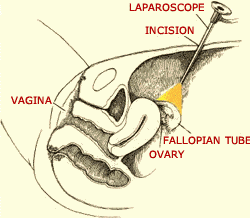
PATENCY OF THE TUBES
LAPAROSCOPY

A lot of information can be obtained about the tubes by actually looking
inside the abdomen with a telescope inserted through a small incision below the navel.
Laparoscope has been designed specifically to allow a very detailed examination of the
inside of the abdomen. The uterus, tubes and ovary can
be inspected without making large incisions. This procedure generally has to be performed
with the patient anesthetized
and therefore may require a day in the hospital. Some gynecologists perform this procedure
under local anesthesia,
but most use general
anesthesia.
Laparoscopy can
reveal adhesions from previous infection that may be blocking the tubes, as well as more
subtle adhesions outside the tube that could interfere
with their ability to pick up the egg. Laparascopy can allow one to examine the
surface of the ovaries to see if there is
scarred appearance, which suggests that ovulation
is not occurring. Furthermore, laparascopy is the only way of making a
firm diagnosis of endometriosis.
Such endometrial implants are a major cause of infertility. Laparoscopy can also be used as a
confirmatory procedure by injecting a blue-colored liquid into the uterus through the cervix and
observing through the telescope whether this fluid spills freely through the tube into the
abdomen. Sometimes tubes that appear to be
blocked on an x-ray are shown really to be open on laparascopy.
|
